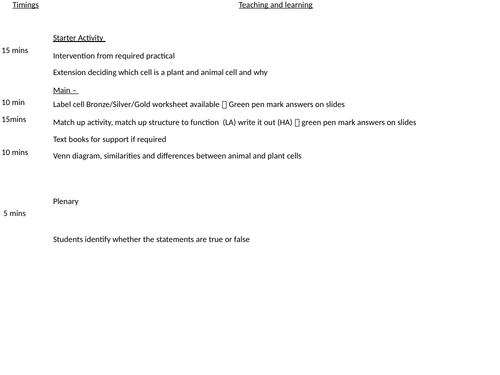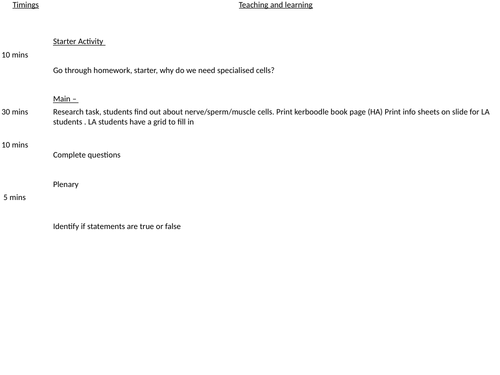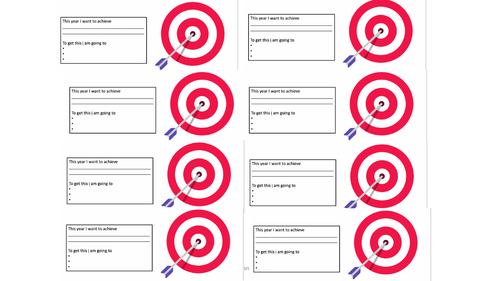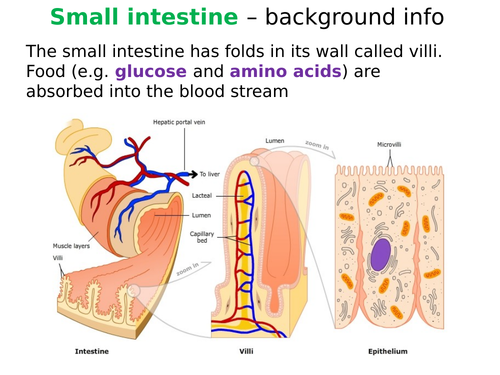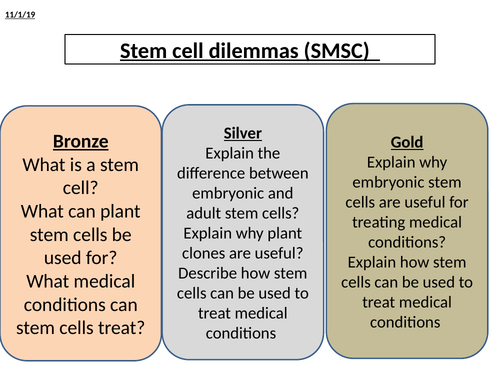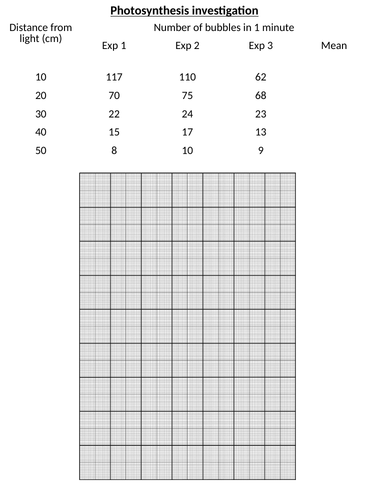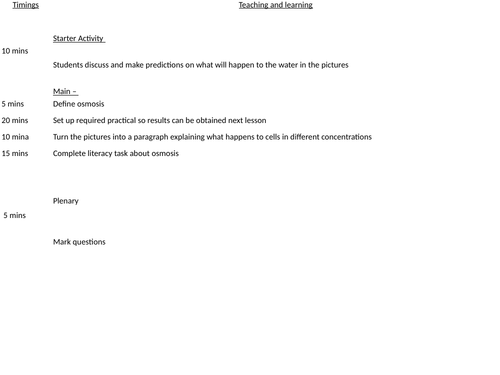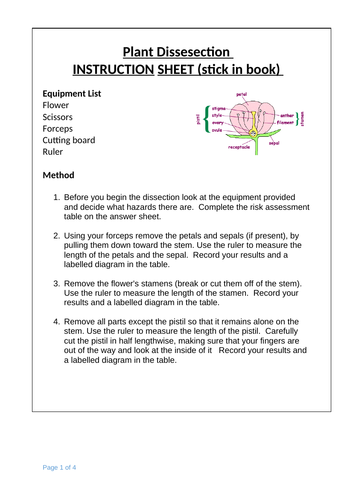
123Uploads
29k+Views
8k+Downloads
Biology

B1.2 Animal and plant cells
Aimed at a mixed ability year 9 class
Starter: identify which cell is a plant cell and which is an animal cell and explain why
Main: Label plant and animal cells differentiated worksheets (bronze silver gold)
Match up strucutre and function of organelles
venn diagram similarities and differences between plant and animal cells
Plenary: true/false questions

B1.4 Specialised animal cells
Aimed at a mixed ability year 9 class
Starter: why do animals have specialised cells, try and identify cells in the pictures
Main: Research task - using kerboodle books or any other resource, research criteria to meet for each cell.
Lower ability information sheets, and grid to fill in for LA students
Extension: answer questions
Plenary: identify if statements are true/ false

B1.10 exchanging materials
Aimed at mixed ability year 9 class
Starter: discuss surface area practical from diffusion lesson
Main: Explain surface area: vol and practice how to work it out
research how different multi cellular animals are adapted
extension: kerboodle checkpoint follow up level 4/6/8
plenary: what have they learnt today

Magnification
Starter: Retrieval starter, based on prior knowledge about animal and plant cells
Main:
explaination of how to convert between common units used in biology
Differentiated task to convert between units
-explaination of how to use standard form
questions to practice on standard form
microscope questions to explain examples
differentiated magnfication worksheet
Plenary:
plenary grid with questions from this lesson and based on animal and plant cells. to be done individually or as a group

B2.4 stem cell dilemmas
aimed at a mixed ability class
Starter: differentiated starter questions, with answers on following slide
Main: mini debate to start, 6 statemenets rate from 1-5 on 1 being comfortable 5 being completely against.
Students watch video to hear some viewpoints about the use of stem cells. students then are given one statement so they either need to argue for or against stem cell research using their knowledge from the video and from the information sheets
Whole class debate
Finally summarise the points on the board into two columns, one for stem cell research one against stem cell research
Plenary: exam question

B2 - cell division revision foundation
Revision powerpoint with booklet
for foundation students
Booklet contains activities and information for students to complete

B16.1 feeding relationships
Aimed at low ability KS4 students, targets of level 3/4
Starter: Differentiated synoptic questions linking to B8 photosynthesis.
Main: match up key words, then link key words to food chain.
differentiated 6 mark question.
Broken down 6 mark question to build confidence, focusing on key words. Bronze/silver supportive sheets Gold students just answer the question.
Plenary: Mark scheme on powerpoint for students to mark and improve their answer.

Photosynthesis KS3
Starter: Recap of a plant cell.
Main - intro to photosynthesis, defintion and explaination
Video with questions to answer
Student task to explain photosynthesis with a clear success criteria given
Discuss how we can measure the rate of photosythesis
Pondweed practical could be done at this point, alternatively there is a online simulation attached.
Give students data, work out the mean, plot a graph write an evaluation. Work sheet for support given with results table and graph.
plenary - recap questions from earlier in the topic

B1.9 active transport
Aimed at a mixed ability year 9 class
Starter: what would happen to the particles thinking about diffusions
Main: introduce active transport, define active transport. show where it works in plants and animal cells
complete differentiated literacy activity
Extension task
Plenary: mark work, tweet one thing they have learnt today

B1.10 exchange materials
Aimed at a mixed ability year 9 class
Starter: reflect on previous diffusion practical
Main: explain surface area:vol, do practic equestions and mark
do research task to explain how surfaces are specialised
extension: checkpoint follow ups from kerboodle
Plenary" tweet what theyve learnt

B1.6 Diffusion
Aimed at a mixed ability year 9 class
Starter: how do sharks find their prey easily
define diffusion
Main:: three practicals
affect of temperature
affect of concentration
affect of surface area
accompanying work sheet to fill in whilst completing practical
THen complete differentiated diffusion literacy task
Plenary: tweet what they have learnt today

B1.7 Osmosis
Aimed at a mixed ability year 9 class
Starter: Discuss and make a prediction about where the water willl move
bring it together with a definitoin of osmosis
Main: Set up practical so results can be looked at next lesson - method on slide
go through what happens to cells in different concentrations
differentiated literacy task
Plenary: mark questions

B1.8 Osmosis in plants
Aimed at a mixed ability year 9 class
Starter: what is the role of a vacuole
stretch: what happens to a plant cell if placed in concentrated sugar solution
Main: Complete required practical, record results, compelte worksheet
extension exam question if do complete
Plenary: mark required practical

B2.3 stem cells
aimed at a mixed ability year 9 class - worksheet from tes
Starter
What is a stem cell. Turn the picture into words – looking for key words, undifferentiated, differentiated
Main –
Watch a video, explaining what stem cells are and what they can be used for
Research task, differentiated criteria to find out about stem cells use p.30-31 in kerboodle text books, ipads
extension: worksheet with questions
Plenary
Peer assess each others work, which level do they think their partner has achieved, using the success criteria

B2.2 Growth and division
Aimed at a mixed ability year 9 class
Could do the practical - but where it falls with teaching my class this im unable to, task to use the method instead
Starter: Students discuss how cells change through the life time of a human
Go through what happens at each stage in life, students then write their own description in their books of what happens at each stage
Stretch: if cells are repaired and replaced and there are stem cells how are people paralysed
Main –
Discuss how plants grow – key words on the board, from discussion get students to write their own definitons for these words, green pen their answers
Turn method for how to clone cauliflower into a storyboard – alternatively you can carry out the practical.
Extension questions if students finish task
Plenary
Explain why a starfish is more like a plant than an animal in terms of its ability to regrow limbs

Structure of a plant
Aimed at KS3 students.
This lesson recaps KS2 prior knowledge on the structure of a plant. Before moving onto KS3 content about structure and function of parts of the plant, followed by a plant dissection, accompanied by worksheets.

KS3 Respiratory system and gas exchange
Starter: Simple recall questions based on prior knowledge, easily changed to suit your class
Main:
Information about the respiratory system, then a labelling task, a putting in order task and questions to consolidate learning. All answers on the powerpoint.
Gas exchange information on the ppt also a drawing of how it can be taught under the visulisar, followed by questions to check understaning.
Plenary
True or false

Photosynthesis and use of glucose
Starter Activity
No goal retrieval starter. Students given a picture of the structure of the leaf and annotate what they can remember.
Go through answers, students annotate anything they did not already know.
Main –
Students listen whilst teacher explains what photosynthesis is (5minutes)
Students answer task 1 and task 2 – write the equation and describe the process of photosynthesis (10 minutes) Success criteria can be given to LA students for support
Go through answers, success criteria on the board, question students for answers, green pen answers (5 minutes)
Students think of the answer to the questions on the board whilst demonstrate the testing for starch test.
Students move around the room to find ways plants use glucose
Plenary
Differentiated exam questions

B2.1 Cell division
Aimed at a mixed ability year 9 class
Starter: match up the key words to the defintions
Main: discuss key words and then think pair share, how do we go from a single cell to an embryo to who we are today
Research mitosis, move around the room and find out about the steps
Complete literacy question task to reinforce learning for the day
Plenary: go through answers to the worksheet and tweet the most important thing they have learnt today

